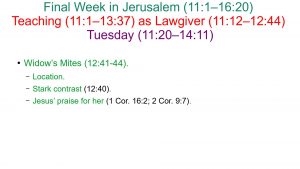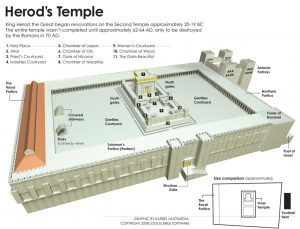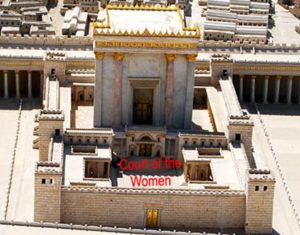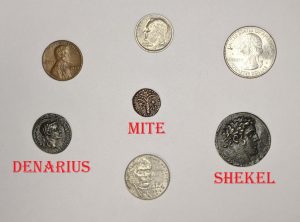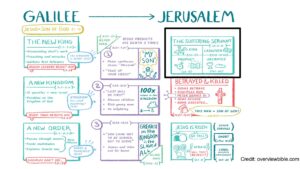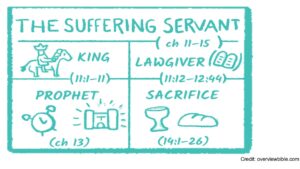Jesus’ Final Week in Jerusalem
Mark 11:1–16:20
Teaching (11:1–13:37)
King (11:1-11)
Sunday: Triumphal Entry (11:1-11).
Lawgiver (11:12–12:44)
Monday (11:12-19).
Tuesday (11:20–14:11).
Lesson from Fig Tree (11:20-26).
Jesus’ Authority Questioned (11:27-33).
Parable of Wicked Vinedressers (12:1-12).
On Taxes (12:13-17).
On Resurrection (12:18-27).
The Greatest Commandment (12:28-34).
An Unanswerable Question (12:35-37).
Warning About the Scribes (12:38-40).
Location.
The text says that Jesus was sitting “opposite the treasury.”
The treasury was located in the Court of the Women in the temple complex, though we are not sure exactly where the treasury was inside the court.
The Court of the Women was the closest that Jewish women could get to the temple proper.
It would make sense that a widow would be in this location, putting in her two mites the week of the Passover.
As Jesus just finished talking about the hypocrisy and the flashiness of the scribes, he spots the rich doing something similar by putting in much into the treasury.
By contrast this one widow throws in two mites into the treasury—it made a quadrans.
Recall that widows were some of the most vulnerable members of that society.
Apparently many scribes were involved in devouring their houses to their shame (12:40).
This meant that either they would have even less to put into the treasury, or they simply wouldn’t have enough to take care of their basic needs if they had that to begin with.
I have seen conflicting information as to exactly how much one mite was worth, ranging from 1/256 to 1/288 of a denarius. One source says that it’s worth 6 minutes of average daily wage—recall a denarius is worth one day’s wages.
The Greek word for this is lepton. If you’re familiar with your particle physics, the generic term for the smallest (or one of the smallest) of subatomic particles is the lepton. The most commonly known lepton is the electron.
It must not have been a coin familiar to the Romans, so Mark compares it to the smallest of the Roman coins, the quadrans, worth twice that of a lepton.
Clearly this poor widow didn’t have much more than this, and she gave what little she could.
Compared to the opulence and decadence of the scribes and the rich, it was disgusting.
That doesn’t mean we shouldn’t give if we are rich, but it does mean we do not have to be showy about it.
Jesus clearly praises this poor woman for the sacrifice she was willing to make for the Lord.
As we talked about with the scribes devouring widows’ houses, this passage is often used by such unscrupulous men to con the poor out of what little money they have.
Sacrifice is good, and the Lord blesses those who give so much of themselves.
However, we do not want to be like those who “devour widows’ houses.”
What’s the best way to express this idea of sacrifice without the ulterior motive such unscrupulous men have?
Ultimately whatever you choose to give is between you and God. The three basic principles of giving found in the NT: 1) as we’ve been prospered, 2) as we’ve purposed, and 3) cheerfully (1 Cor. 16:2; 2 Cor. 9:7).
If you haven’t been prospered, give what you can, even if it’s just a few pennies.
Of course, it’s curious to note that Jesus praises this widow for giving more than those who were rich.
One way we often interpret this is that Jesus is referring to percentage, that the widow was giving a greater percentage of what she had more than the percentage given by the wealthy.
One commentator disagrees with this, however, saying: “The precise point of Jesus is not a monetary one; not, for example, that the poor widow gave a larger percentage of her money. The thought is that by giving all when others gave out of savings, she gave herself to God. … Her dedication was heartfelt and inconspicuous and … God … [looks at] the heart” (Stauffer 305).
What do you make of that? Do you agree with that assessment, that’s it wasn’t about percentage, but about inconspicuous sacrifice and dedication?
Another commentator, pointing out the contrast between this widow and the scribes, says, “[The scribes] sought to squeeze the last penny from widows out of greed, but the poor widow gave the last penny to the Lord out of love and self-sacrifice” (Black 221).
She was truly a remarkable woman, and a model for us all when it comes to our dedication to the Lord’s service—quiet, unassuming, and complete.
This was the last of Jesus’ public teaching. In the next chapter, He speaks to His disciples privately as a prophet.
Prophet (13:1-37)
 On Temple’s Destruction (13:1-30).
On Temple’s Destruction (13:1-30).Difficulties in interpretation.
This next chapter is known as the Olivet Discourse, named for the fact that it took place on the Mount of Olives. We also find it in Matthew 24 and Luke 21.
This is perhaps one of the most controversial passages in the book of Mark, as is the Olivet Discourse in the other accounts.
When dealing with prophetic texts, and especially those that are eschatological, people tend to interpret things in many ways.
Eschatology is a fancy word to describe a study of the end times—“end” could refer to the end of the age or the end of the world.
 I have found four primary ways of interpreting this passage. I will label them as: futurist, partial preterist, preterist, and historicist.
I have found four primary ways of interpreting this passage. I will label them as: futurist, partial preterist, preterist, and historicist.These are labels given to different eschatological schools of thought, though they are not strictly what we are discussing today despite some similarities.
Futurist is the belief that all the events discussed are yet to come—our dispensational premillenialists fall into this category (i.e. rapture, 7-year tribulation, etc.). They will contend that the entire Olivet Discourse is yet to come.
This belief is untenable, however, based on 13:30—many of the events discussed in this chapter would happen within a generation.
I have found that most faithful brothers fall into the partial preterist category, the idea that some of the events discussed occurred in the first century, while some have yet to occur.
The transition between the two is admittedly subtle, subtle enough that the next group denies it altogether.
These faithful brothers hold the preterist position concerning this passage, a belief that all of the foretold events have already taken place.
Not every preterist position is sound (Max King Theory), since they believe that every prophecy of Scripture has been fulfilled, but it is possible when considering the Olivet Discourse.
 The historicist position is actually a mix of partial preterism and historicism. Historicism suggests that some of the Olivet Discourse is concerning general persecutions in history, but nothing specific. The partial preterist aspect holds that some things refer to specific things in the past, while others refer to things to come.
The historicist position is actually a mix of partial preterism and historicism. Historicism suggests that some of the Olivet Discourse is concerning general persecutions in history, but nothing specific. The partial preterist aspect holds that some things refer to specific things in the past, while others refer to things to come.This can all be rather confusing, but the central message is clear (13:35-37).
At the same time, many of the things discussed in this chapter are very typical of persecutions against Christians, so we can also take modern application.
We will consider primarily the partial preterist and preterist positions here, especially since the first 30 verses or so are not in dispute between them (mostly).
